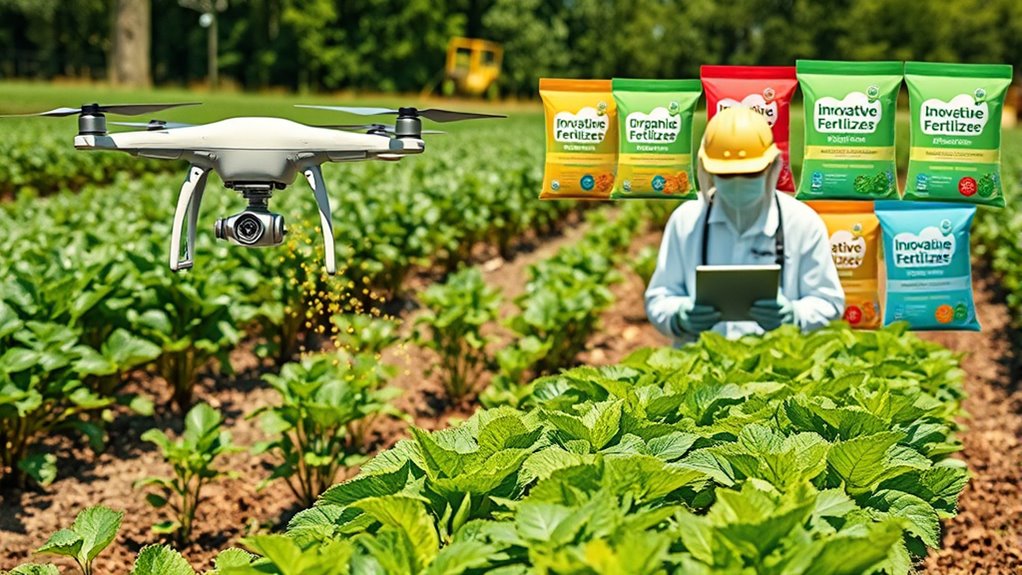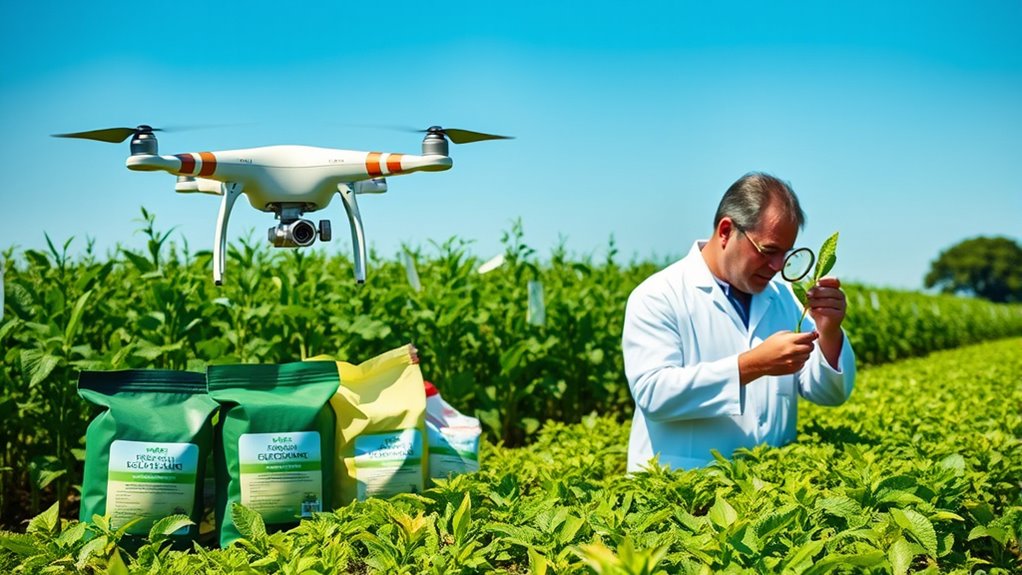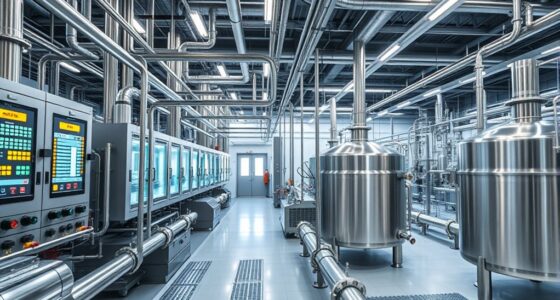Agricultural chemistry trends focus on developing fertilizers that boost crop yields while reducing environmental impact. Innovations include organic options like compost and manure, slow-release and microbial solutions, and Eco-friendly biofertilizers. These alternatives help prevent soil degradation, water pollution, and greenhouse gas emissions common with conventional fertilizers. Advances in precision agriculture and nutrient recovery promote sustainable practices. To explore how new technologies are shaping future farming, keep exploring the latest eco-friendly solutions transforming agriculture today.
Key Takeaways
- Innovations include slow-release, microbial, and bio-based fertilizers to enhance efficiency and reduce environmental impact.
- Growing focus on eco-friendly options like compost, manure, and liquid extracts for sustainable soil health.
- Advances in nutrient recovery technologies enable circular economy practices, minimizing reliance on mined minerals.
- Precision agriculture tools optimize fertilizer application, reducing runoff, leaching, and greenhouse gas emissions.
- Development of carbon-neutral nitrogen production and electrification aims to cut climate impacts of fertilizer manufacturing.
Types of Fertilizers and Their Innovations

Have you ever wondered how different fertilizers boost crop growth and soil health? There’s a wide variety, each with unique benefits. Organic fertilizers, made from plants and animals, improve soil biodiversity and long-term fertility. Organic fertilizers enhance microbial activity, which helps break down organic matter and release nutrients more effectively. Inorganic fertilizers are synthetic and act quickly, providing essential nutrients like nitrogen, phosphorus, and potassium. Innovations in organic options include composting tech, cover cropping, liquid fertilizers, manure management, and microbial solutions that boost nutrient absorption naturally. On the other hand, specialized inorganic fertilizers like calcium nitrate or ammonium sulfate target specific soil needs or crop requirements. Slow-release fertilizers, whether synthetic or organic, release nutrients gradually, ensuring sustained feeding. Slow-release fertilizers can reduce nutrient runoff and improve efficiency over time. Green alternatives like biofertilizers and biostimulants offer eco-friendly options, reducing reliance on chemicals and promoting healthier soil ecosystems.
Environmental Challenges of Conventional Fertilizers

Are conventional fertilizers causing more harm than we realize? Overusing nitrogen fertilizers leads to soil acidification and disrupts natural nutrient balances, harming soil health. Continuous heavy application reduces microbial diversity, which is essential for healthy soil ecosystems. Research shows that excess nitrogen can also leach into groundwater, contaminating drinking water supplies. This imbalance also lowers soil organic matter, making soils less fertile, more prone to erosion, and less water-retentive. Nutrient runoff, especially nitrogen and phosphorus, pollutes waterways, triggering algal blooms and creating dead zones like in the Gulf of Mexico. Additionally, fertilizer use releases potent greenhouse gases—nitrous oxide, which is 300 times more warming than CO₂—contributing considerably to climate change. Excess nutrients also threaten biodiversity, favoring invasive species and disrupting ecosystems. Plus, airborne ammonia from fertilizers impacts air quality and public health, posing further environmental challenges.
Green and Eco-Friendly Fertilizer Alternatives

Switching to green and eco-friendly fertilizer alternatives offers a sustainable way to nourish your plants while minimizing environmental impact. You can use natural options like compost, which improves soil structure and water retention, or manure, rich in nitrogen, phosphorus, and potassium that boosts microbial activity. Organic fertilizers provide essential nutrients derived from natural sources. Bone meal provides slow-release phosphorus for root development, while fish emulsion supplies nitrogen and trace minerals. Liquid seaweed enhances plant resilience with growth hormones and micronutrients. Homemade fertilizers like rice water, compost tea, and banana peel tea add nutrients and support beneficial microbes. These alternatives reduce runoff, support soil microbiomes, and increase soil carbon storage. Using organic fertilizers also helps conserve water and avoids synthetic chemicals harmful to aquatic ecosystems, making your gardening more sustainable.
Production and Economic Trends in Sustainable Fertilizer Development

Advancements in sustainable fertilizer production are transforming the agriculture industry by focusing on environmentally friendly technologies and efficient practices. Electrification through water electrolysis reduces reliance on fossil fuels and cuts carbon emissions.
Innovations like slow-release and micro-encapsulated fertilizers improve nutrient efficiency and lessen environmental harm. Precision agriculture enables precise application, minimizing waste and maximizing crop yields.
Researchers are exploring carbon-neutral methods for nitrogen fertilizer production to combat climate change. Efficiency ratings are crucial for selecting models that provide better energy savings and performance, which can be applied to developing more sustainable fertilizer technologies. Economically, the global market is set to grow from $199.82 billion in 2024 to $279.52 billion by 2033, driven by technological innovations and government subsidies.
Despite regulatory hurdles and price volatility, the push for greener methods is shaping a more sustainable and resilient fertilizer industry, aligning economic growth with environmental responsibility.
Nutrient Recovery and Circular Economy in Agriculture

Building on recent innovations in sustainable fertilizer production, nutrient recovery technologies are now at the forefront of promoting a circular economy in agriculture. You can recover nitrogen and phosphorus from wastewater by producing struvite and ammonium salts, turning waste into valuable fertilizers.
Data-driven tools optimize nutrient extraction from digestate, making processes more sustainable. Pilot projects convert dairy manure into nutrient-rich biochar via pyrolysis, reducing waste and improving soil health.
The LIFE ENRICH process demonstrates adaptability across various wastewater treatment plants, ensuring safety standards by managing contaminants. These efforts create closed-loop systems that reuse organic residuals, decreasing reliance on mined minerals.
Implementing nutrient recovery practices not only enhances resource efficiency but also contributes significantly to reducing environmental pollution and greenhouse gas emissions. Circular practices cut emissions, lower environmental impact, and promote resource conservation. Collaborations between sectors and supportive policies are essential to scale these innovations and fully realize their environmental and economic benefits.
Frequently Asked Questions
How Do Microbial Fertilizers Adapt to Different Soil Types?
You might wonder how microbial fertilizers adapt to different soil types. They do this by containing microorganisms that adjust their activity to soil conditions like pH, moisture, and texture.
These microbes enhance nutrient solubilization, fix nitrogen, and produce growth hormones suited for specific soils. As a result, they improve soil structure, fertility, and plant growth across diverse environments, ensuring effective nutrient availability regardless of soil variations.
What Are the Long-Term Impacts of Biofertilizers on Soil Health?
Imagine your soil as a thriving ecosystem, and biofertilizers act as its gentle healers. Long-term, they revitalize and balance the soil’s natural rhythms, much like nourishing roots strengthen a mighty tree.
You’ll see improved resilience against droughts and floods, fewer chemical dependencies, and sustained productivity.
Over time, your soil becomes a resilient, vibrant foundation—supporting healthy crops and a healthier planet—making your farming truly sustainable.
How Can Farmers Effectively Transition to Eco-Friendly Fertilizer Practices?
To effectively shift to eco-friendly fertilizers, you should start with soil testing to understand nutrient needs.
Incorporate organic matter like compost and use precision application techniques to minimize waste.
Adopt microbial-based fertilizers and products like NutriCharge® to improve phosphorus mobility.
Educate yourself and others through training, rotate crops, and gradually reduce synthetic fertilizer use.
These steps will help you improve soil health, reduce environmental impact, and guarantee sustainable farming practices.
What Policies Support the Adoption of Sustainable Fertilizer Technologies?
Imagine you’re in a future where green fertilizers are common; policies today make that possible. Governments support sustainable practices through regulations like mandatory neem-coated urea, standards for bio-based fertilizers, and incentives for eco-friendly tech.
They offer subsidies, grants, and education programs to help you adopt these methods. International frameworks also promote harmony in standards, ensuring you have the tools and guidance to shift seamlessly toward greener fertilizer technologies.
Are Nano-Fertilizers Safe for Human Health and the Environment?
You might wonder if nano-fertilizers are safe. Currently, they pose health risks because their tiny size allows deep penetration into biological systems, potentially causing cell damage and respiratory issues.
Environmentally, they can contaminate soil and water, with long-term effects still unclear. Without proper regulation or guidelines, it’s risky to use them widely.
Green alternatives like compost and crop rotation offer safer, sustainable options for both health and environment.
Conclusion
By embracing innovative fertilizers, reducing environmental impacts, and exploring green alternatives, you can shape a sustainable future. You can optimize crop yields, protect ecosystems, and promote resource efficiency all at once. You can support circular economies, foster eco-friendly practices, and drive agricultural progress. Together, by choosing sustainable solutions, you can cultivate a healthier planet, a resilient agriculture, and a brighter tomorrow.









